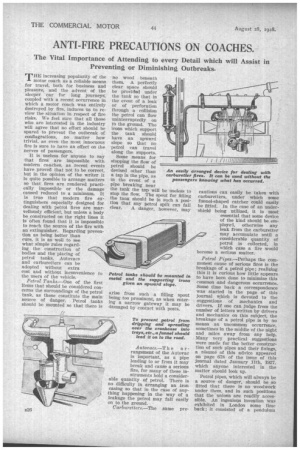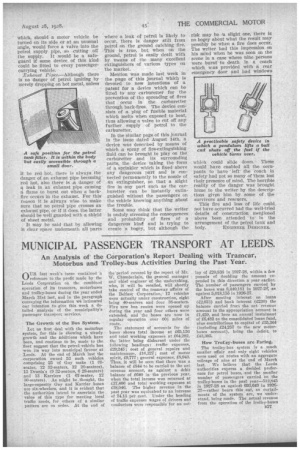ANTI-FIRE PRECAUTIONS ON COACHES.
Page 10

Page 11

If you've noticed an error in this article please click here to report it so we can fix it.
The Vital Importance of Attending to every Detail which will Assist in Preventing or Diminishing Outbreaks.
THU increasing popularity of the motor coach as a reliable means for travel, both for business and pleasure, and the advent of the sleeper car for long journeys, coupled with a recent occurrence in which a motor coach was entirely destroyed by fire, induces us to review the situation in respect of fire risks. We feel sure that all those who are interested in the industry will agree that no effort should be spared to prevent the outbreak of conflagrations, no matter how trivial, as even the most innocuous fire is sure to have an effect on the nerves of passengers.
It is useless for anyone to say that fires are impossible with modern coaches, as recent events have proved that not to be correct, but in the opinion of the writer it is quite possible to arrange matters so that fires are rendered practically impossible or the damage caused reduced to a minimum. It is true that modern fire extinguishers especially designed for dealing with petrol fires are marvellously efficient, but unless a body be constructed on the right lines it is often found that it is impossible to reach the source of the fire with an extinguisher. Regarding prevention as being better than cure, it is as well to see what simple rules regarding the construction of bodies and the placing of petrol tanks, Autovacs and carburetters can be adopted without extra cost and without inconvenience to the users of the vehicle.
Petrol Tanks.—One of the first Items that should be considered concerns the surroundings of the petrol tank, as these constitute the main source of danger. Petrol tanks should be mounted so that there is
no wood beneath them. A perfectly clear space should be provided under the tank so that in the event of a leak or of perforation through a collision the petrol can flow uninterruptedly on to the ground. The irons which support the tank should have an upward slope so that no 'petrol can travel along the supports.
Some means for stopping the flow of petrol should be devised other than a tap in the pipe, as in the event of a pipe breaking near the tank the tap will be useless to stop the flow, The spout for filling the tank should be in such a position that any petrol spilt can fall clear. A danger, however, may arise from such a filling spout being too prominent, as when entering a narrow gateway it may be damaged by contact with posts.
Autovacs.—T ii e a r
rangement of the Autovac is important, as a pipe leading to or from it may break and cause a serious fire, for many of these in struments hold a considerable quantity of petrol. There is no difficulty in arranging an iron casing so that in the case of anything happening in the way of a leakage the petrol may fail easily on to the ground.
Carburetters.—The same pre
cautions can easily be taken with carburetters, under which some funnel-shaped catcher could easily be fitted. In the case of an undershield being utilized, it is most essential that some device of the kind should be employed, otherwise any leak from the carburetter may accumulate until a considerable quantity of petrol is collected, in which case a fire would become a serious matter.
Petrol Pipes.—Perhaps the commonest cause of serious fires is the breakage of a petrol pipe; realizing this it is curious how little appears to have been done to minimize this common and dangerous occurrence. Some time back a correspondence was started in the page of this journal which is devoted to the suggestions of mechanics and drivers. If one can judge from the number of letters written by drivers and mechanics on this subject, the breakage of a petrol pipe is by no means an uncommon occurrence, sometimes in the middle of the night and miles away from any help. Many very practical suggestions were made for the better construction of such pipes and their fixings, a résumé of this advice appeared on page 678 of the issue of this journal dated January 11th, 1927, which anyone interested in the matter should look up.
Petrol pipes, which will always be a source of danger, should be so fitted that there is no woodwork under them, and in such positions that the unions are readily accessible. An ingenious invention was exhibited in London some time back; it consisted of a penduluin which, should a motor vehicle be turned on its side or at an unusual angle, would force a valve into the petrol supply pipe, so cutting off the supply. It would be a safeguard if some device of this kind could be fitted to every passengercarrying vehicle. Exhaust Pipes.—Although there is no danger of petrol igniting by merely dropping on hot metal, unless
it be red hot, there is always the danger of an exhaust pipe becoming red hot, also there is al danger • of
leak in an exhaust pipe causing A flame to burst out when a backfire occurs in the exhaust. For this reason it is always wise to make Sure that no petrol pipe crosses an exhaust pipe, or if it does, the latter should be well guarded with a shield of sheet metal.
It may be said that by allowing 'ea clear space underneath all parts
where a leak of petrol is likely to occur, there is danger still from petrol on the ground catching fire. This is true, but when on the ground, petrol is easily dealt with by means of the many excellent extinguishers of various tYpes on the market.
Mention was made last week in the page of this journal which is devoted to new inventions of a patent for a device which can be fitted to any carburetter for the prevention of th spreading Of fires that occur in the carburetter through back-fires. The device consists of ;a plug of fusible material which melts when exposed to heat, thus allowing a valve to cut off any further supply of petrol to the carburetter.
In the similar page of this journal in the issue dated August 14th, a device was described by means of which a spray of fire-extinguishing fluid can be brought to play on the carburetter and its surrounding parts, the device taking the form of a sprinkler which is fixed above any dangerous part and is connected permanently to the nozzle of an extinguisher, so that a slight fire in any part such as the carburetter can be instantly extinguished without the passengers on the vehicle knowing anything about the trouble.
Some may think that the writer Is unduly stressing the consequences and probability of fires of a dangerous kind and is trying to create .a bogey, but although the
risk may be a slight one, there is no bogey about what the result may possibly be when a fire does occur_ The writer had this impression on his mind when he was soon on the Scene in a case where nine persons were burnt to death in a coach which, was provided with a rear emergency door and had windows
which could slide down. These would have enabled all the occupants to have left' the coach in safety had not so many of them lost their presence of mind. The horrible reality of the danger was brought home to the writer by the descriptions given him by some of. the survivors and rescuers.
This fire and loss of life could not have occurred had the well-tried details of construction men,tioned above been attended to' in the arrangement of the petrol tank and body. ENGINEER DESIGNER.
































